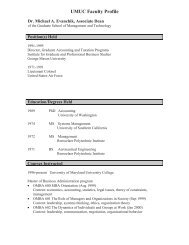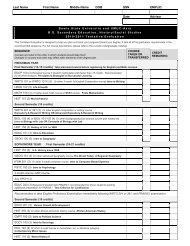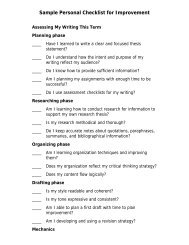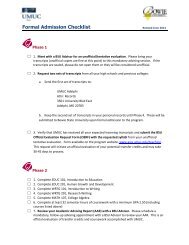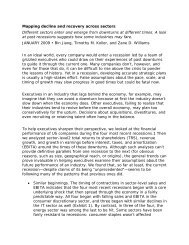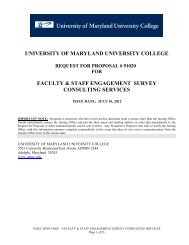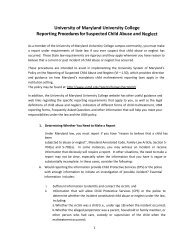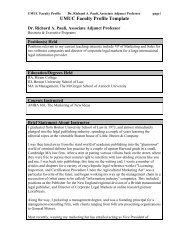COURSE DESCRIPTIONSEDTC 640 Technology Change Management in Schools (3)(Formerly OMED 670.) An overview <strong>of</strong> the theories,approaches, and strategies that help teachers assume leadershiproles in implementing technology change in K–12 schools. Topicsinclude the role <strong>of</strong> change agents in K–12 schools, strategiesto meet the needs <strong>of</strong> technologically unskilled teachers, tools andtechniques to respond to diverse competency levels, and varioustraining models and approaches for adult learners. Structuredobservation is employed to critically assess the effectiveness<strong>of</strong> various technology training formats. In a guided project, atechnology-training seminar is designed, developed, and implementedfor delivery to colleagues.EDTC 645 Integration <strong>of</strong> Technology: Global Perspectives (3)(Formerly OMED 690.) Exploration <strong>of</strong> global perspectives onadvancing K–12 student learning through technology. Investigationcovers how schools design innovative units and programsthat take full advantage <strong>of</strong> technology’s ability to reach beyondnational borders and promote global understanding and howvarious nations approach the challenge <strong>of</strong> technology integrationin the schools. Focus is on evaluating best practices in the UnitedStates and other nations and on analyzing the role <strong>of</strong> policy inshaping the way resources are deployed to advance effective technologyintegration. Major projects include designing models forintegrating global understanding into curriculum and instruction,developing case studies <strong>of</strong> technology integration in variouscountries, and evaluating relevant research.EDTC 650 Special Topics in Instructional Technology (3)An exploration <strong>of</strong> current topics in instructional technology,which are <strong>of</strong>fered on a rotating basis. Individual topics focuson advanced instructional multimedia for the K–12 classroom(including building interactive multimedia materials that meetthe learning needs <strong>of</strong> diverse K–12 populations while developingskills using animation and other multimedia technologies)or on teaching and learning in the K–12 virtual school (includingpolicies and structures <strong>of</strong> K–12 virtual schools, teachingand course development strategies appropriate for elementaryand secondary school online courses, and emerging issues in theK–12 virtual enterprise).EDTC 670 Integrative Capstone Project (3)(Formerly OMED 680.) A self-directed project, in which teacherscollaborate with colleagues within or across grade levels ordepartments to incorporate innovations into their curricula. Aportfolio is built to demonstrate the development, implementation,and outcomes <strong>of</strong> the project. Study is designed to provideteachers the opportunity to apply previous knowledge and skillsgained from previous coursework.EDTP (Education: Teacher Preparation)EDTP 600 Pr<strong>of</strong>essional Fundamentals <strong>of</strong> Teaching andLearning (6)Preparation for effective entry into the classroom as a teacher.Topics include teaching in the contemporary school; humandevelopment; approaches to learning, diversity, and collaborationbeyond the classroom; learners with exceptional needs;curriculum, instruction, and assessment; teaching in the contentarea; and synthesis and application. Course materials and assignmentsfocus on documents created and/or typically utilized byschool systems and incorporate current school district initiatives.EDTP 635 Adolescent Development and Learning Needs (6)Preparation to support the unique development <strong>of</strong> adolescentsfrom various backgrounds, with varying beliefs, and with variedabilities. Learners are examined from the standpoint <strong>of</strong> developmentalcharacteristics; social, cultural, racial, and gender affiliation;socioeconomic status; religious influences; learning styles;special needs; and exceptionality. Adolescents are also examinedfrom biological, psychological, cognitive, and social perspectives;within the tapestry <strong>of</strong> their family and community; andthrough the influences <strong>of</strong> societal and cultural norms. Discussioncovers theories and concepts associated with human growth anddevelopment across the lifespan, focusing on typical and atypicaldevelopment <strong>of</strong> the adolescent.EDTP 645 Subject Methods and Assessment (6)An introduction to instructional strategies and curriculum forteaching secondary content that emphasizes effective instructionbased in understanding assessment and how assessmentinforms effective instruction. Topics include development <strong>of</strong>comprehensive assessment strategies and their interrelationshipswith creation <strong>of</strong> learning objectives, selection <strong>of</strong> instructionaltechniques, and preparation <strong>of</strong> instructional plans. Currenttrends in secondary school structures, issues <strong>of</strong> traditional andauthentic assessments, and teacher effect on student achievementare explored. Focus is on meeting individual needs and usecontent knowledge to inform instructional practice by drawingon knowledge gained through previous study and knowledgebases that reflect current research and best practices in secondarycontent areas.98G R A D U A T E C A T A L O G | 2 0 1 0 – 2 0 1 1
EDTP 650 Pr<strong>of</strong>essional Internship and Seminar (9)(Formerly OMAT 606.) Prerequisites: EDRS 600 and 605 andEDTP 640. An opportunity to apply the concepts, techniques,methods, and theories learned in previous coursework and fieldbasedexperiences through a pr<strong>of</strong>essional internship. Internshipactivities require completing observations, activities, and clinicalpractice in an approved secondary classroom appropriate forthe selected subject area certification, under the supervision <strong>of</strong>a school-based mentor and university field supervisor. Weeklyseminar meetings establish a learning community that assures acontinuing support system and provides a forum for feedbackand discussion <strong>of</strong> common readings, experiences, questions, andissues. An electronic portfolio is completed.EMAN (Emergency Management)EMAN 600 Comprehensive Crisis and EmergencyManagement (3)An analysis <strong>of</strong> all hazards, phases (mitigation, preparedness,response, and recovery), and actors involved in crisis and emergencymanagement. Discussion covers the definition <strong>of</strong> crises,emergencies, and disasters and concepts and issues in crisis andemergency management. Focus is on developing crisis, contingency,and incident management plans. Current frameworks,management systems, and command systems for organizing aresponse, deploying resources, managing the response organization,supporting crisis communication, and making decisionsin a turbulent environment are examined. Topics are discussedfrom U.S. and international perspectives.EMAN 610 Hazard Risk and Vulnerability Assessment (3)An examination <strong>of</strong> risk, hazard, and vulnerability. Topicsinclude systematic hazard risk assessment, risk mitigation(reduction), risk transfer, and risk analysis. Discussion coverscontemporary approaches to risk assessment and management<strong>of</strong> naturally or technologically induced hazards. Environmentalhazard assessment is also examined. Seminal works published inthe area are reviewed.EMAN 620 Information Technology in EmergencyManagement (3)An overview <strong>of</strong> the role <strong>of</strong> information in crisis and responsemanagement. Discussion covers disaster and crisis informationrequirements; information technologies and decision supporttools applied to crisis, disaster, and emergency management;and information problems encountered during emergencies.Tools used include the global positioning system (GPS), geographicalinformation systems (GIS), computer hardware, andhazard and emergency management-related s<strong>of</strong>tware packages,as well as decision analysis methods. Assignments include practicalcase studies.EMAN 630 Crisis Communication for Emergency Managers (3)An exploration <strong>of</strong> current strategies and tactics for managingthe range <strong>of</strong> communication responsibilities and issues that ariseduring a variety <strong>of</strong> crisis situations. Traditional and new mediamethods for analyzing crisis and communications managementissues (including the use <strong>of</strong> current technologies) are appliedusing relevant public relations research, theory, and case examples.A strategic approach is used to better identify issues, goals,stakeholders, messaging, and other aspects involved in developingcommunity-specific public responses to crisis situations.EMAN 670 Seminar in Emergency ManagementLeadership (3)Prerequisite: 30 credits, including all core and specializationcourses for the emergency management specialization (exceptMGMT 670). An examination <strong>of</strong> successful leadership in managingcrises, disasters, and emergencies through analysis <strong>of</strong> casestudies. Discussion covers the various characteristics and leadershipstyles most effective in emergency management. Varioustheories, models, historical examples, and practical applicationsare reviewed. Topics include breaking down barriers betweenbureaucratic systems and methods <strong>of</strong> operation; seeking to createa culture <strong>of</strong> disaster prevention and preparedness; acquiringresources for risk assessments, plan development, training, andexercising. Ethics and legal issues in emergency managementand the procurement <strong>of</strong> facilities and supplies are also examined.Focus is on understanding how integrated plans must addressspecific hazards, community vulnerabilities, and risks.w w w.umuc.edu / grad 99
- Page 1 and 2:
2010-2011CatalogGraduate School of
- Page 3 and 4:
From the DeanWelcome to the Univers
- Page 5 and 6:
IMPORTANT DATESCONTACT INFORMATIONA
- Page 7 and 8:
About the Graduate SchoolMISSION ST
- Page 9 and 10:
Online courses maintain the sameaca
- Page 11 and 12:
Other Dual Degree CombinationsMaste
- Page 13 and 14:
DOCTOR OF MANAGEMENT IN COMMUNITYCO
- Page 15 and 16:
student teaching. Students are advi
- Page 17 and 18:
Career Paths■■■■■■■
- Page 19 and 20:
CAREER PATHS■■■■■■■
- Page 21 and 22:
RELATED CERTIFICATE PROGRAMSInitial
- Page 23 and 24:
PartnershipsUMUC currently offers p
- Page 25 and 26:
program emphasizes development of m
- Page 27 and 28:
RELATED CERTIFICATE PROGRAMSInitial
- Page 29 and 30:
■■■■■■■■Government
- Page 31 and 32:
PartnershipAn articulation agreemen
- Page 33:
CAREER PATHS■■■■■■■
- Page 36 and 37:
MASTER’S DEGREE ANDCERTIFICATE PR
- Page 38 and 39:
MASTER’S DEGREE ANDCERTIFICATE PR
- Page 40 and 41:
MASTER’S DEGREE ANDCERTIFICATE PR
- Page 42 and 43:
MASTER’S DEGREE ANDCERTIFICATE PR
- Page 44 and 45:
MASTER’S DEGREE ANDCERTIFICATE PR
- Page 46 and 47:
MASTER’S DEGREE ANDCERTIFICATE PR
- Page 48 and 49:
MASTER’S DEGREE ANDCERTIFICATE PR
- Page 50 and 51: MASTER’S DEGREE ANDCERTIFICATE PR
- Page 52 and 53: MASTER’S DEGREE ANDCERTIFICATE PR
- Page 54 and 55: MASTER’S DEGREE ANDCERTIFICATE PR
- Page 56 and 57: MASTER’S DEGREE ANDCERTIFICATE PR
- Page 58 and 59: MASTER’S DEGREE ANDCERTIFICATE PR
- Page 60 and 61: MASTER’S DEGREE ANDCERTIFICATE PR
- Page 62 and 63: MASTER’S DEGREE ANDCERTIFICATE PR
- Page 64 and 65: MASTER’S DEGREE ANDCERTIFICATE PR
- Page 66 and 67: MASTER’S DEGREE ANDCERTIFICATE PR
- Page 68 and 69: EXECUTIVE PROGRAMSEver-sharper comp
- Page 70 and 71: EXECUTIVE PROGRAMSCHIEF INFORMATION
- Page 72 and 73: DUAL DEGREE PROGRAMSMASTER OF BUSIN
- Page 74 and 75: DUAL DEGREE PROGRAMSMASTER OF BUSIN
- Page 76 and 77: DUAL DEGREE PROGRAMSMASTER OF BUSIN
- Page 78 and 79: MASTER’S DEGREE ANDCERTIFICATE PR
- Page 80 and 81: DUAL DEGREE PROGRAMSMASTER OF DISTA
- Page 82 and 83: DUAL DEGREE PROGRAMSMASTER OF SCIEN
- Page 84 and 85: COURSE DESCRIPTIONSINDEX TO COURSE
- Page 86 and 87: COURSE DESCRIPTIONSACCT 613 Federal
- Page 88 and 89: COURSE DESCRIPTIONSASCM 629 Strateg
- Page 90 and 91: COURSE DESCRIPTIONSBSBD (Biosecurit
- Page 92 and 93: COURSE DESCRIPTIONSCJMS 640 Crimina
- Page 94 and 95: COURSE DESCRIPTIONSDBST 667 Data Mi
- Page 96 and 97: COURSE DESCRIPTIONSDMBA (Business A
- Page 98 and 99: COURSE DESCRIPTIONSDMGT 892 Dissert
- Page 102 and 103: COURSE DESCRIPTIONSEMBA (Business A
- Page 104 and 105: COURSE DESCRIPTIONSENVM 650 Land an
- Page 106 and 107: COURSE DESCRIPTIONSHAIN 670 Health
- Page 108 and 109: COURSE DESCRIPTIONSHRMD 630 Recruit
- Page 110 and 111: COURSE DESCRIPTIONSIMAN 670 Managin
- Page 112 and 113: COURSE DESCRIPTIONSINMS 630 Espiona
- Page 114 and 115: COURSE DESCRIPTIONSMGMT 615 Intercu
- Page 116 and 117: COURSE DESCRIPTIONSMSAS (Accounting
- Page 118 and 119: COURSE DESCRIPTIONSPMAN (Project Ma
- Page 120 and 121: COURSE DESCRIPTIONSPRPA 650 Public
- Page 122 and 123: COURSE DESCRIPTIONSTLMN 670 Capston
- Page 124 and 125: ADMINISTRATIONUniversity Systemof M
- Page 126 and 127: ADMINISTRATIONGRADUATE SCHOOL OF MA
- Page 128 and 129: CONTACT INFORMATIONPROGRAM DIRECTOR
- Page 130 and 131: ADMISSION AND ENROLLMENTGeneral Inf
- Page 132 and 133: ADMISSION AND ENROLLMENTBY MAILStud
- Page 134 and 135: ADMISSION AND ENROLLMENTEmployer-Pr
- Page 136 and 137: ACADEMIC AND ADMINISTRATIVEREQUIREM
- Page 138 and 139: ACADEMIC AND ADMINISTRATIVEREQUIREM
- Page 140 and 141: SERVICES AND RESOURCESAvailability
- Page 142 and 143: SERVICES AND RESOURCESStudents must
- Page 144 and 145: SERVICES AND RESOURCESand the compl
- Page 146 and 147: SERVICES AND RESOURCESfor an additi
- Page 148 and 149: FACULTYAbbott, Weldon LeonAdjunct P
- Page 150 and 151:
FACULTYBartoo, DianeProgram Directo
- Page 152 and 153:
FACULTYCallahan, Caryl A.Collegiate
- Page 154 and 155:
FACULTYCrews, Gordon A.Adjunct Prof
- Page 156 and 157:
FACULTYEsler, Anne G.Adjunct Assist
- Page 158 and 159:
FACULTYGlickstein, Ira S.Adjunct As
- Page 160 and 161:
FACULTYHilliard, Philip E.Adjunct A
- Page 162 and 163:
FACULTYKeenan, Susan L.Adjunct Asso
- Page 164 and 165:
FACULTYLloyd, Karl B.Adjunct Associ
- Page 166 and 167:
FACULTYMerkulov, Gennady V.Adjunct
- Page 168 and 169:
FACULTYParks, Janet M.Adjunct Assis
- Page 170 and 171:
FACULTYRoberts, Judith M.Adjunct As
- Page 172 and 173:
FACULTYSimoncen, Anne LouiseAdjunct
- Page 174 and 175:
FACULTYTurner, Marvin W.Adjunct Ass
- Page 176 and 177:
FACULTYWysocki, Carol D.Adjunct Pro
- Page 178 and 179:
UNIVERSITY POLICIESIV.CRITERIAStude
- Page 180 and 181:
UNIVERSITY POLICIESC. Faculty Advis
- Page 182 and 183:
UNIVERSITY POLICIESREINSTATEMENT OF
- Page 184 and 185:
UNIVERSITY POLICIESB. Directory Inf
- Page 186 and 187:
INDEXAAACRAO. See American Associat
- Page 188 and 189:
INDEXDDatabase systems technologyce
- Page 190 and 191:
INDEXInstructional sites, 4, 127Ins
- Page 192 and 193:
INDEXTechnology managementcourse de
- Page 194 and 195:
NOTES192G R A D U A T E C A T A L O
- Page 196:
ABOUT UMUCUniversity of Maryland Un





